An Environmentally-Friendly Tourist Village in Egypt Based on a Hybrid Renewable Energy System––Part One: What Is the Optimum City?
Abstract
:1. Introduction
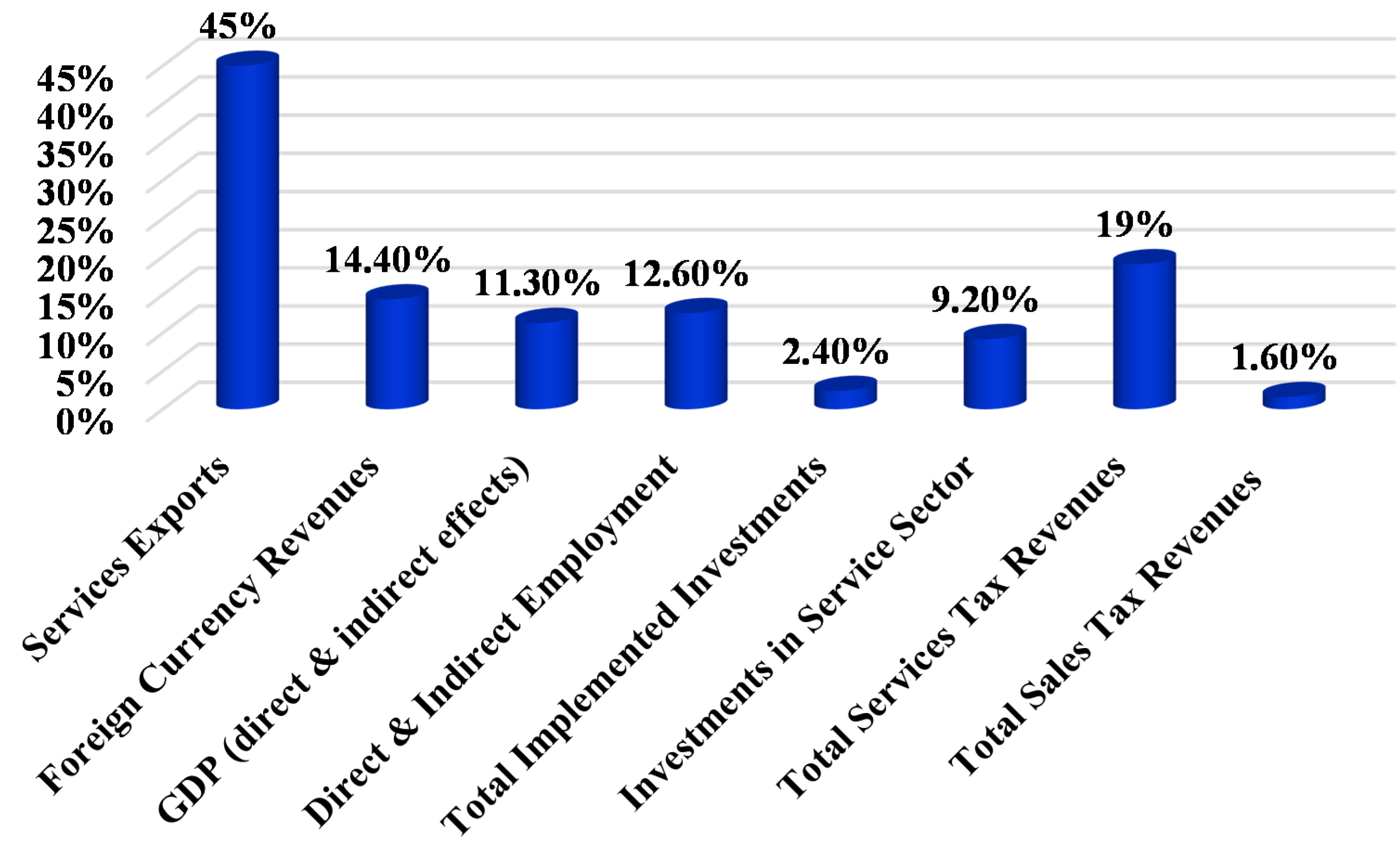
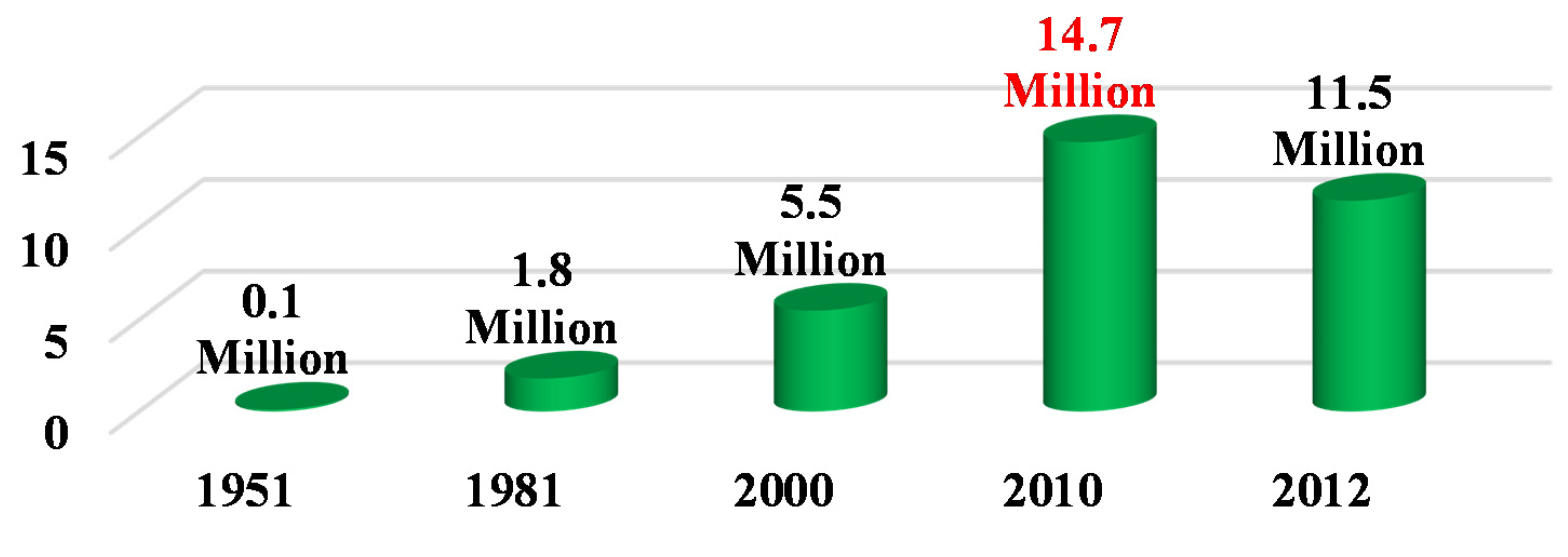
2. Data Collection
2.1. Load Profile

2.2. Solar Energy Resource
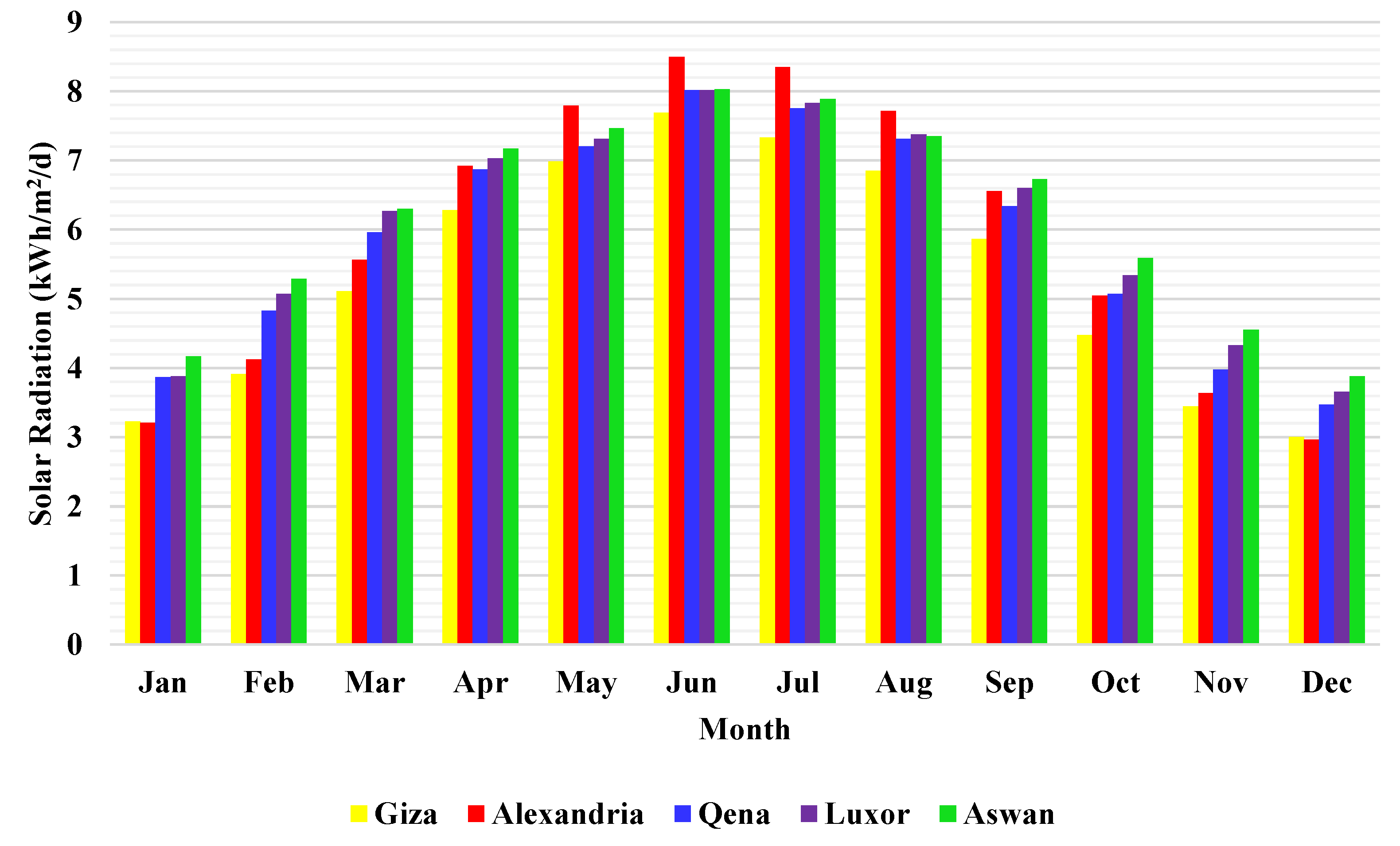
2.3. Wind Energy Resource
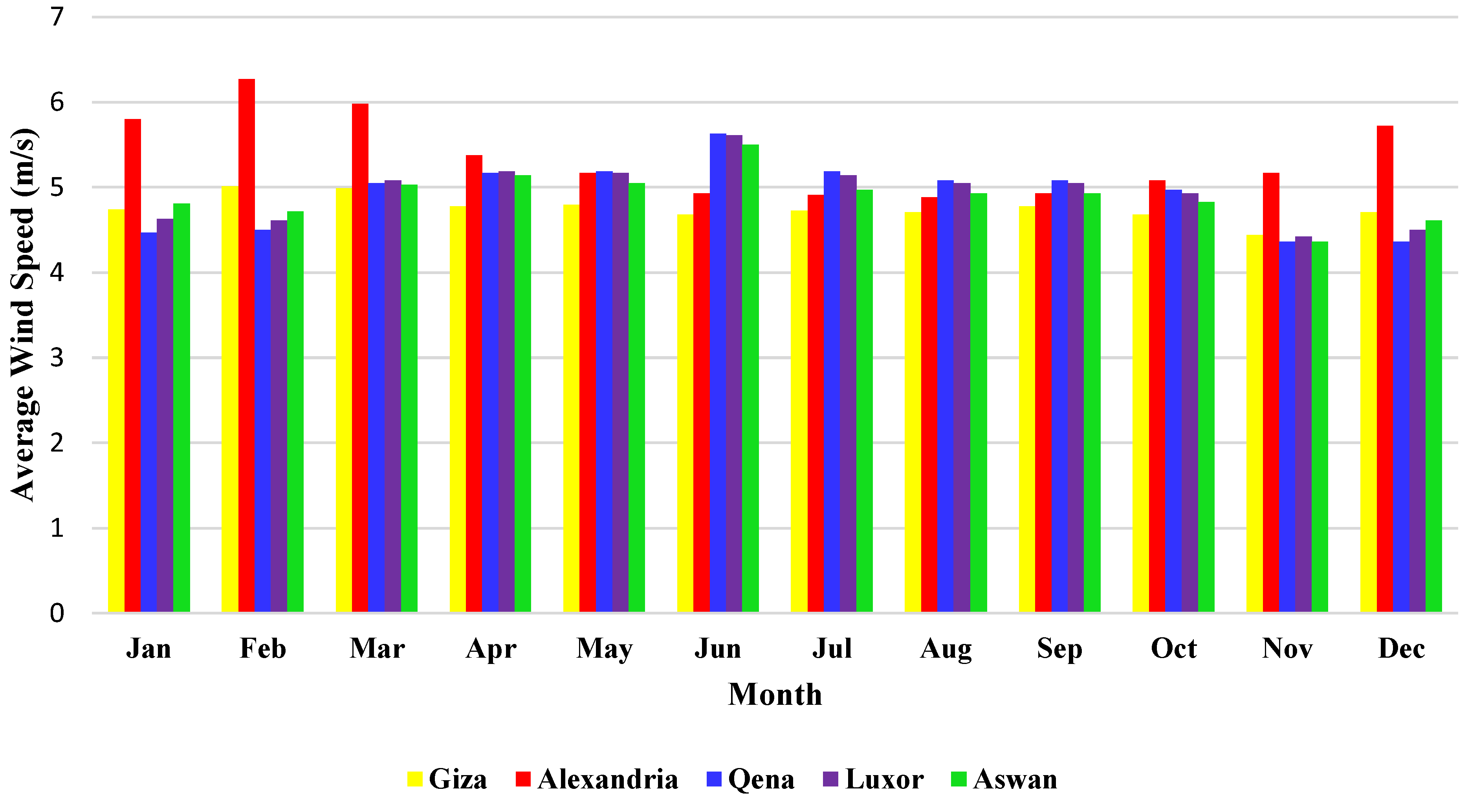
2.4. Temperature Resource
- , PV derating factor;
- , solar radiation incident on the PV module at the current time (kW/m2);
- , solar radiation at standard test conditions (1 kW/m2);
- , power output of the PV module under standard test conditions (kW);
- , temperature of the PV module at the current time (°C);
- , temperature of the PV module under standard test conditions (25 °C);
- , temperature coefficient of the PV module (%/°C).
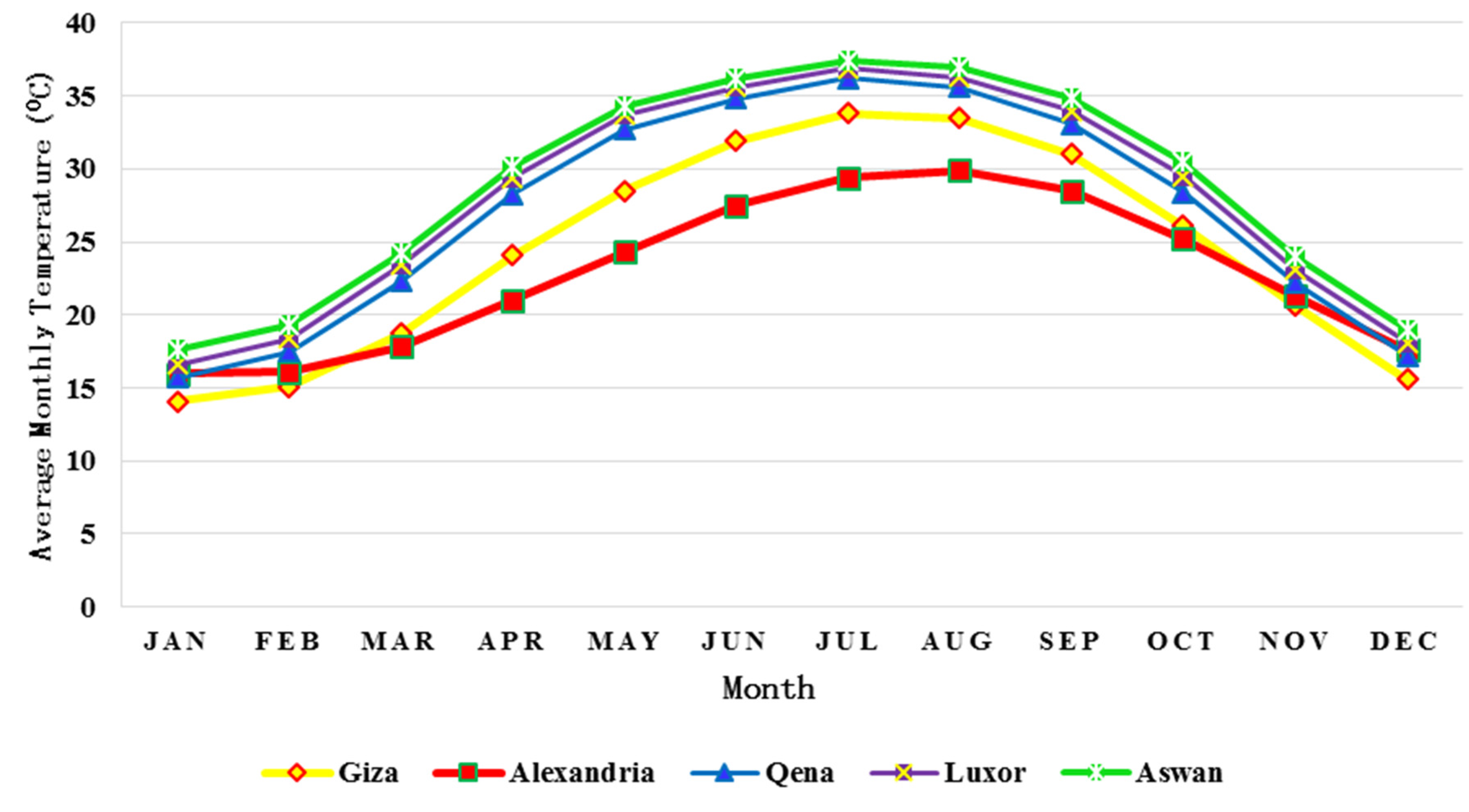
3. Hybrid System Modeling
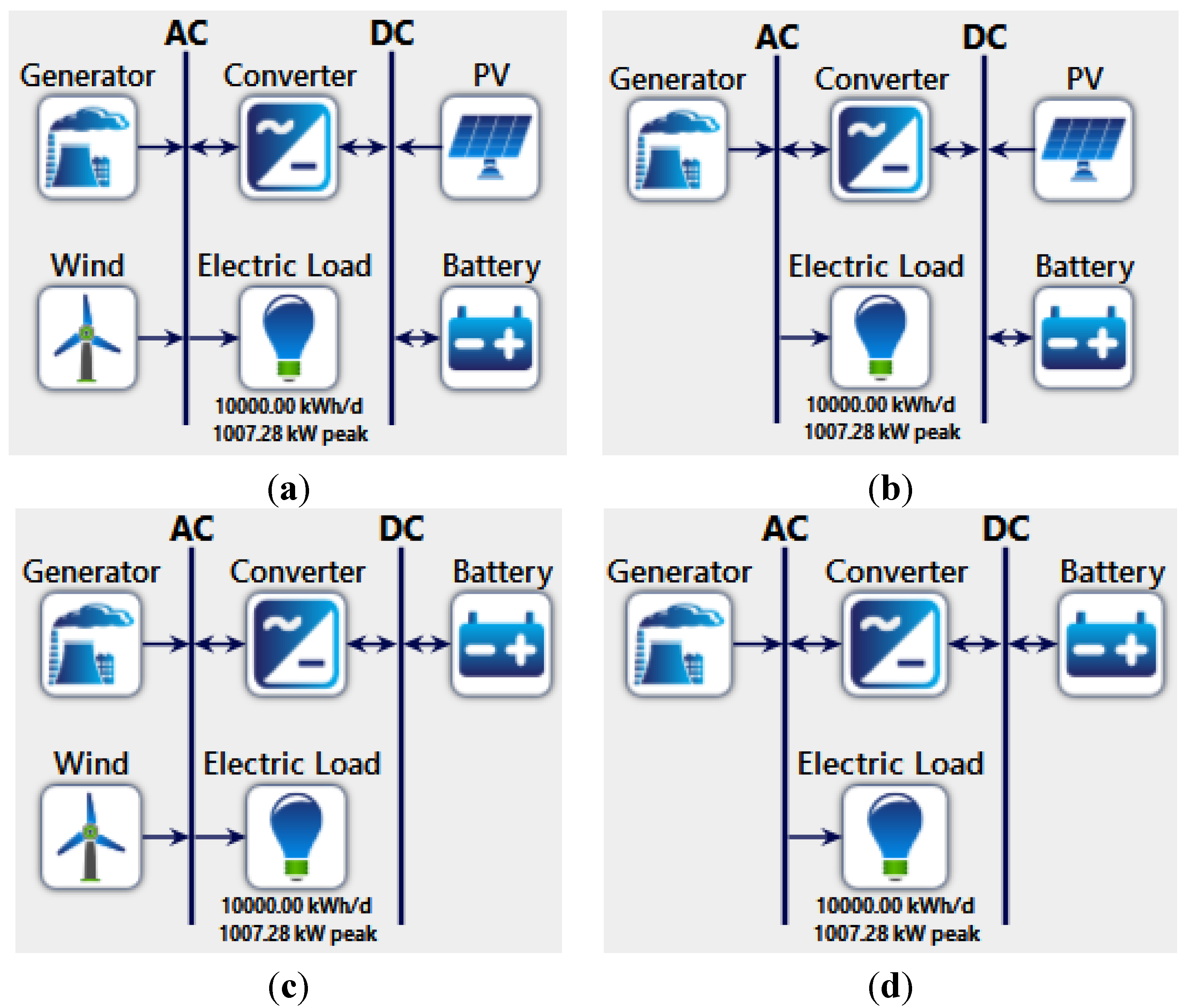
| Component | Capital Cost | Replacement Cost | O & M Cost | Life Time |
|---|---|---|---|---|
| PV module | $3000/kW | $2500/kW | $10/year | 20 years |
| Wind turbine | $4000/kW | $3000/kW | $50/year | 20 years |
| Power converter | $800/kW | $600/kW | $5/year | 15 years |
| Battery | $300/kWh | $250/kWh | $10/year | 12,600 kWh |
| Diesel generator | $400/kW | $300/kW | $0.25/hour | 15,000 h |
| Technical Details | Value |
|---|---|
| Derating factor | 80% |
| Ground reflection | 20% |
| Converter efficiency | 90% |
| Fuel cost | $0.24/L |
| Annual nominal interest rate | 8% |
| Project lifetime | 25 years |
4. Results and Discussions
4.1. Selection of the City According to the Economic Cost
- COE and NPC represent the levelized cost of energy and the total net present cost of the system without considering the effects of ambient temperature or applying GHG emission penalties.
- COE_T and NPC_T represent the levelized cost of energy and the total net present cost of the system with considering the effects of ambient temperature.
- COE_P and NPC_P represent the levelized cost of energy and the total net present cost of the system, taking GHG emission penalties into consideration.
- COE_P_T and NPC_P_T represent the levelized cost of energy and the total net present cost of the system, taking GHG emission penalties and the effects of ambient temperature into consideration.
4.1.1. Hybrid PV/Wind/Diesel/Battery System
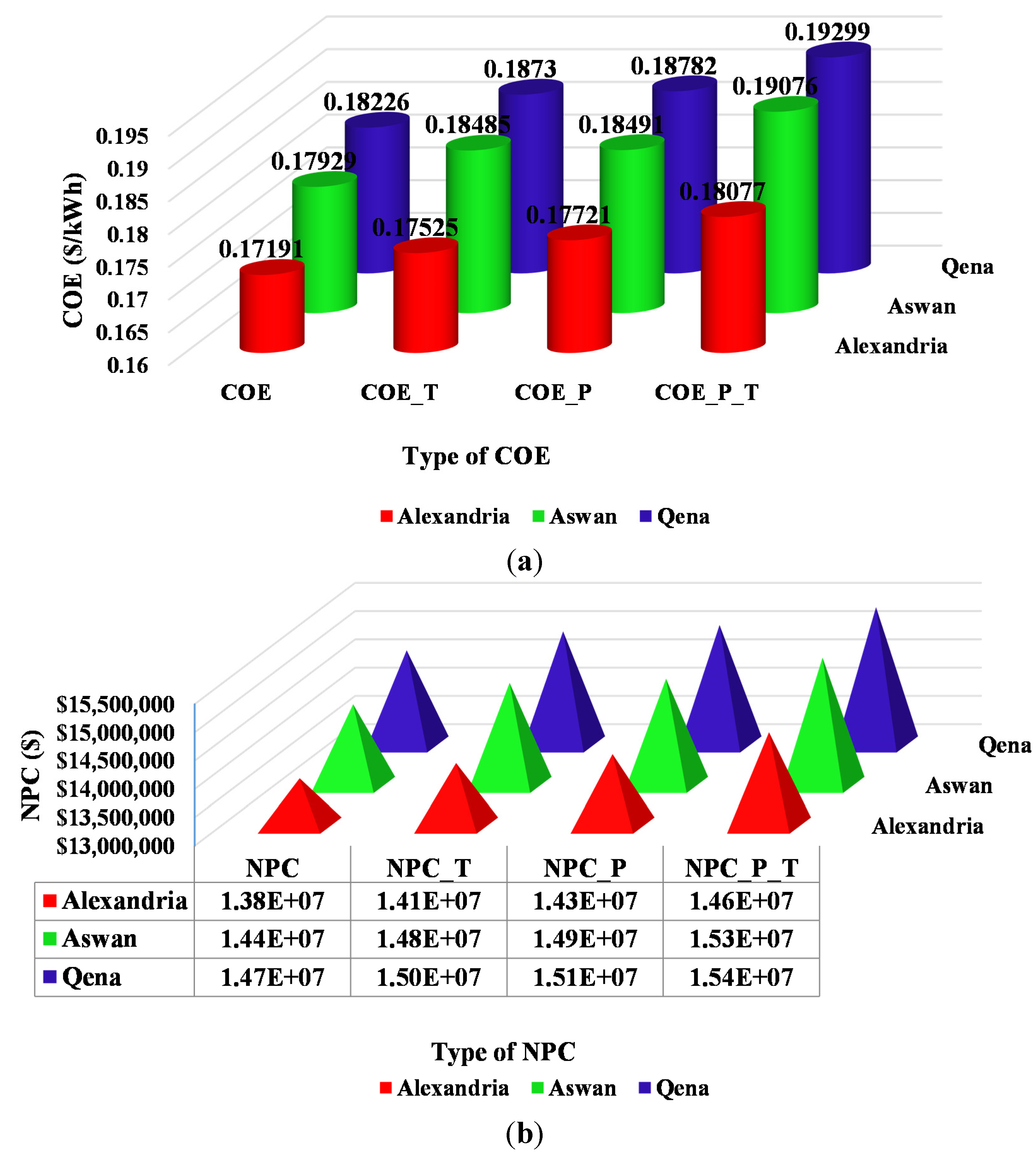
4.1.2. Hybrid PV/Diesel/Battery System
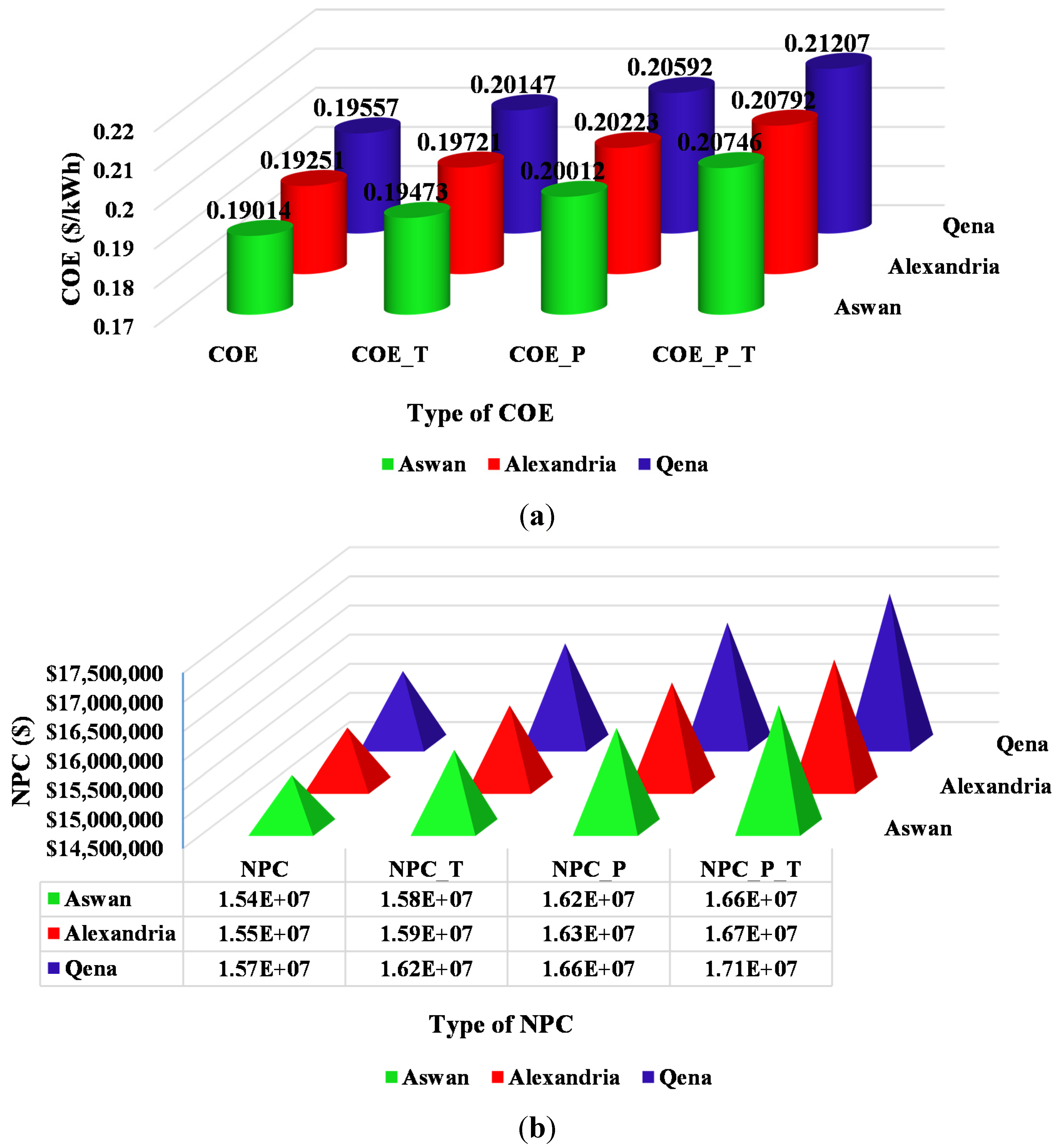
4.1.3. Hybrid Wind/Diesel/Battery System
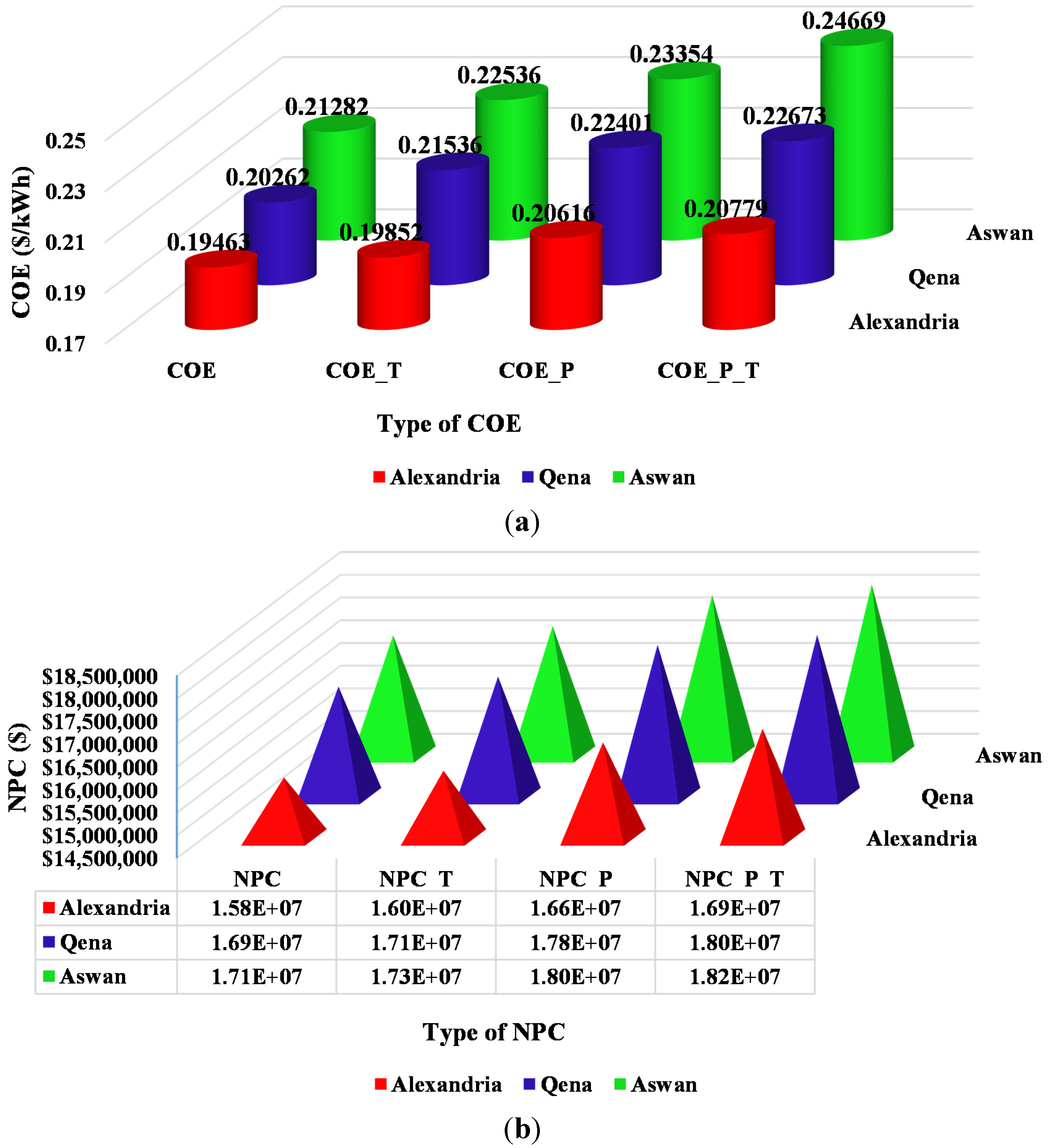
4.1.4. Diesel/Battery System
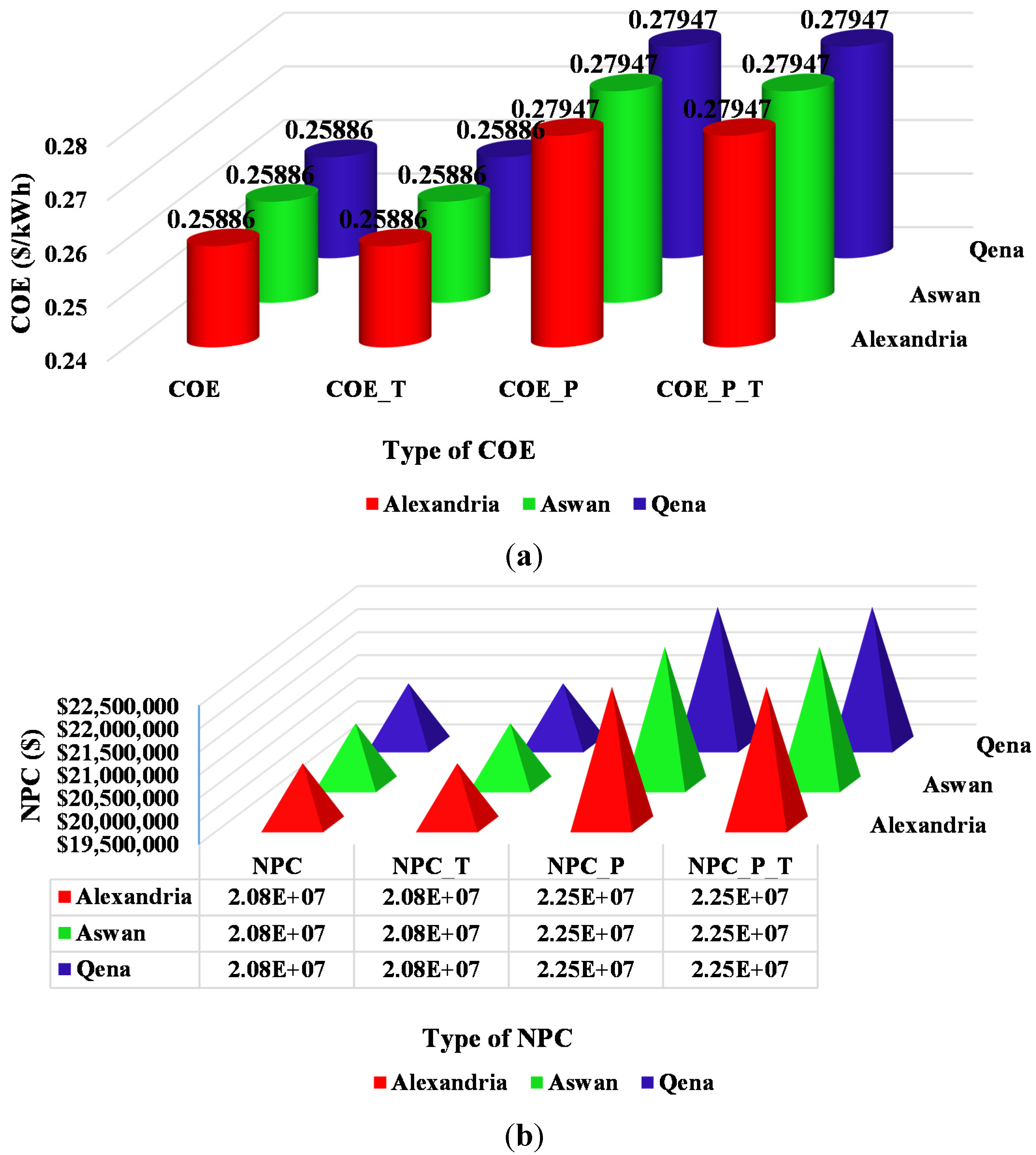
4.2. Selection the City According to the Amount of GHG Emitted
4.2.1. Hybrid PV/Wind/Diesel/Battery System

4.2.2. Hybrid PV/Diesel/Battery System
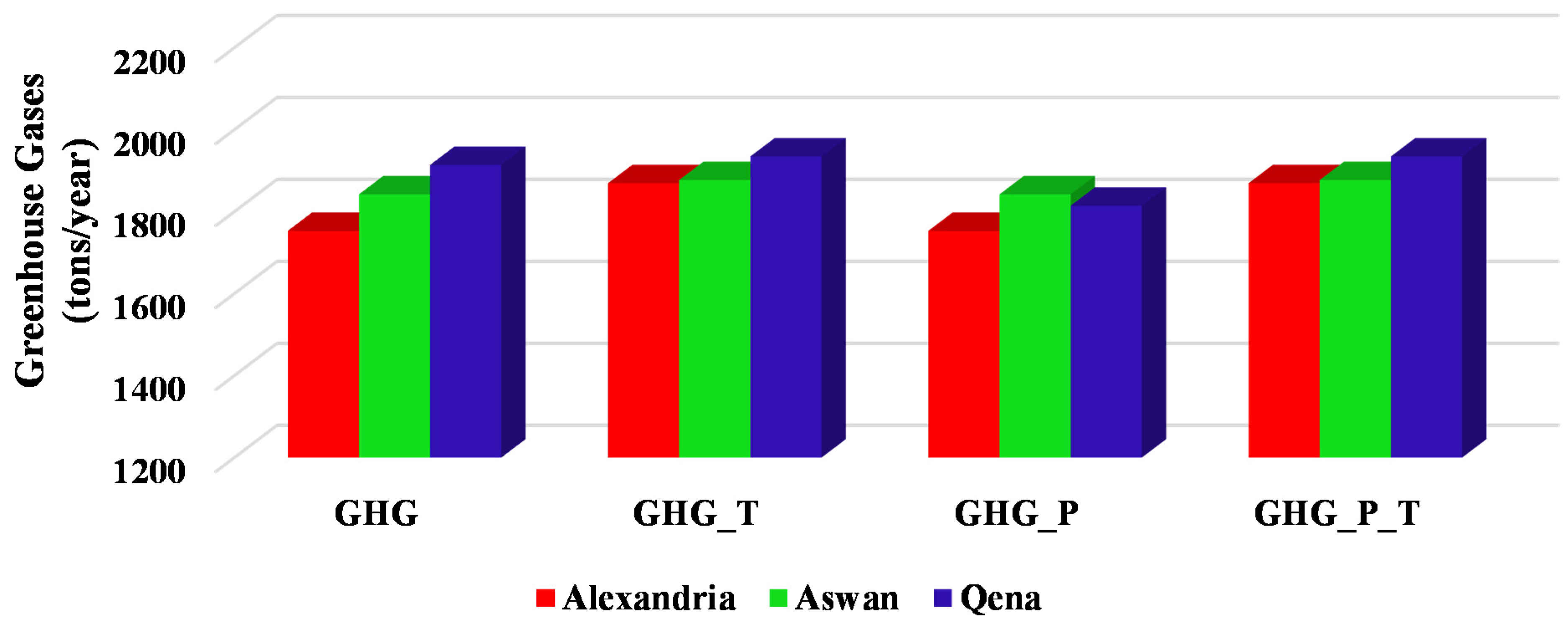
4.2.3. Hybrid Wind/Diesel/Battery System
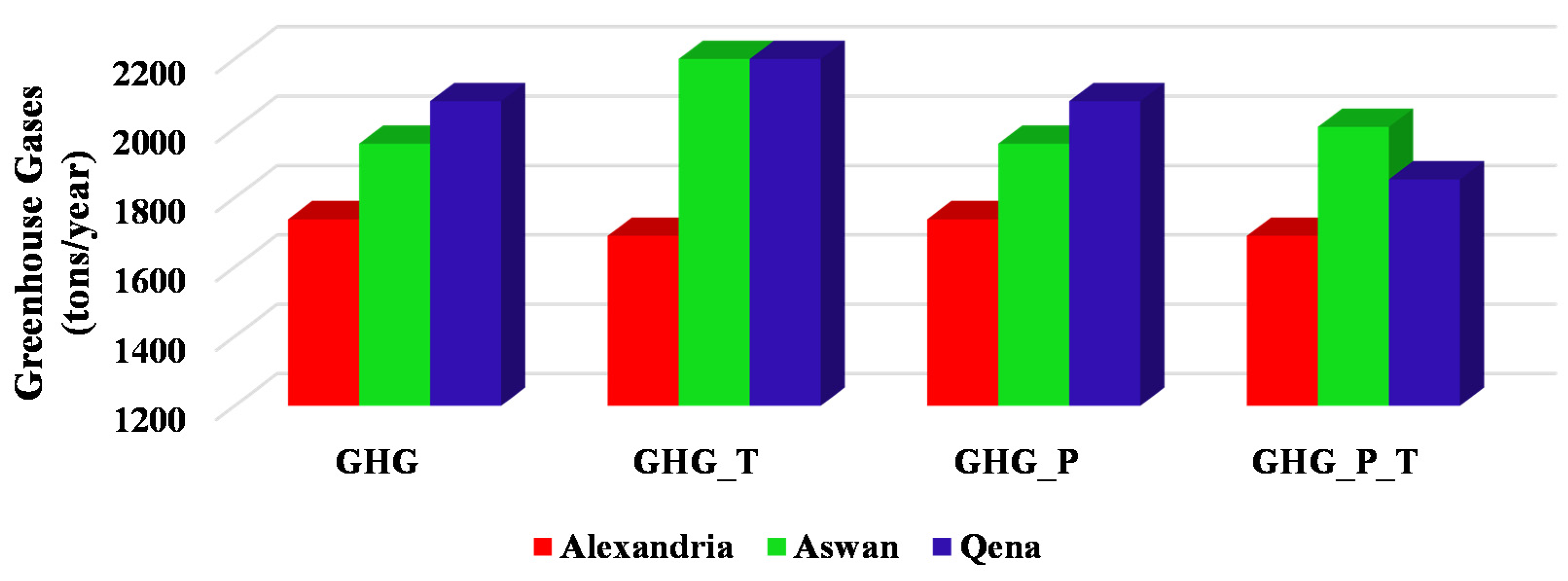
4.2.4. Diesel/Battery System
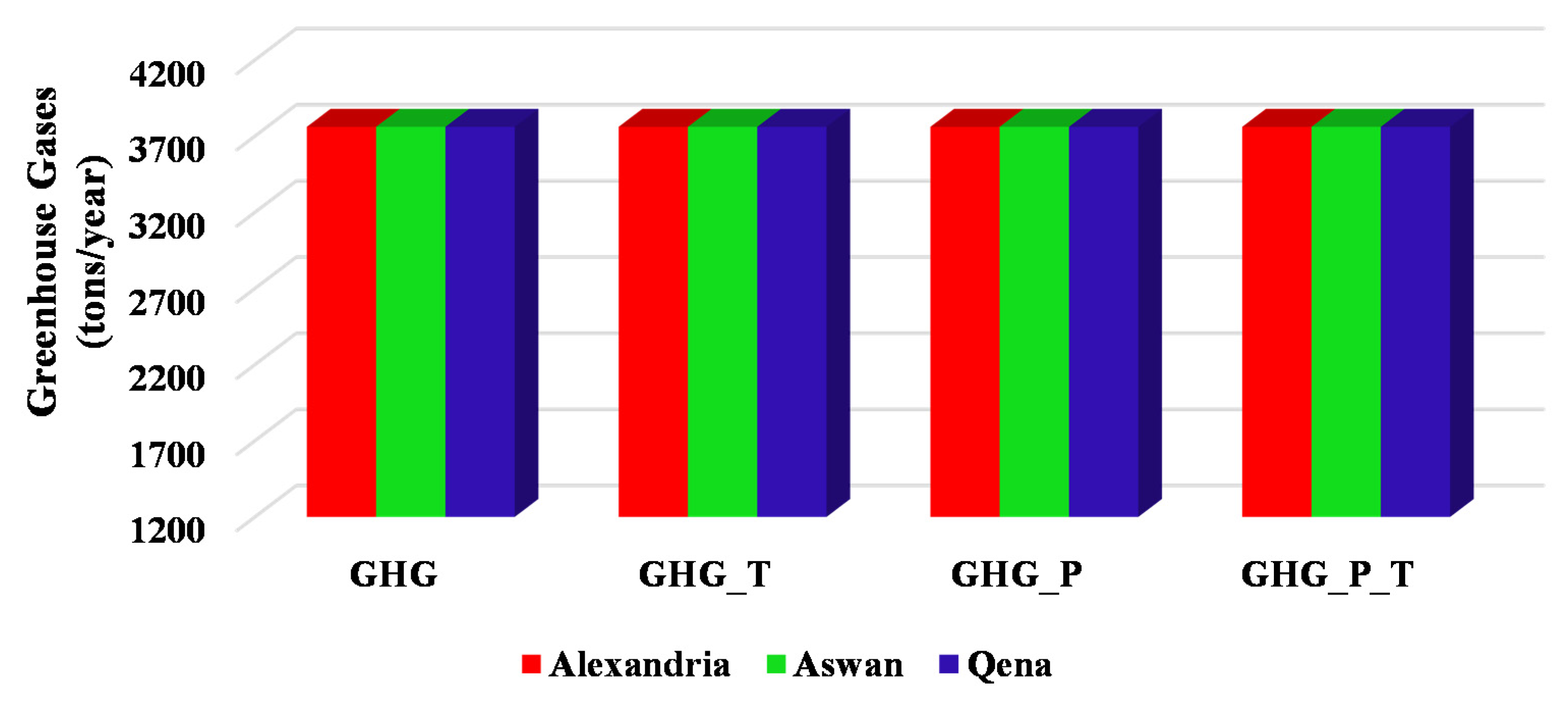
5. Conclusions
- The selection of the optimum city from five touristic Egyptian cities (Luxor, Giza, Alexandria, Qena and Aswan) to establish an environmentally-friendly tourist village has been carried out according to the economic cost (COE and NPC) and the amount of GHG emitted.
- The selection of the optimum city has been carried out in four cases based on the effects of ambient temperature and applying GHG emission penalties for different configurations of HRES.
- Alexandria is the most economic city for a hybrid PV/wind/diesel/battery system in comparison with Aswan and Qena.
- Aswan is the economic city for a hybrid PV/diesel/battery system compared to the other two cities, Alexandria and Qena.
- Alexandria is the most economic city for a hybrid wind/diesel/battery system in comparison with Qena and Aswan.
- For diesel/battery, system there is no difference between the three cities according to the economic cost, but for the same city there is a significant difference according to the economic cost based on applying GHG emission penalties.
- There is no large difference in GHG amount emitted from a PV/wind/diesel/battery system in any of the three cities, ignoring the effects of ambient temperature and GHG emission penalties.
- Qena is the optimum city for a PV/wind/diesel/battery system according to the amount of GHG emitted in comparison with the other two cities, if the effects of ambient temperature are considered.
- Aswan is the optimum city for a PV/wind/diesel/battery system according to the amount of GHG emitted compared to the other two cities, if the GHG emission penalties are applied.
- Alexandria is the optimum city for a PV/wind/diesel/battery system according to the amount of GHG emitted compared to the other two cities if the effects of ambient temperature are considered and GHG emission penalties are applied.
- Alexandria is the optimum city for a PV/diesel/battery system according to the amount of GHG emitted compared to the other two cities if the effects of ambient temperature and GHG emission penalties are neglected, or applying GHG emission penalties.
- There is no large difference between Alexandria and Aswan for a PV/diesel/battery system according to the amount of GHG emitted if the effects of ambient temperature or both the effects of ambient temperature and GHG emission penalties are taken into consideration.
- Alexandria is the optimum city for a wind/diesel/battery system according to the amount of GHG emitted compared to the other two cities regardless of considering the effects of ambient temperature, applying GHG emission penalties or considering the effects of both.
- According to the amount of GHG emitted from a diesel/battery system, there is no difference between the three cities under the study.
Author Contributions
Conflicts of Interest
References
- Fourteenth Meeting, Committee of Statistics and Tourism Satellite Account (TSA). Recent Development of TSA in Egypt. Available online: http://statistics.unwto.org/event/14th_meeting (accessed on 20 April 2015).
- Egypt Tourism Numbers to Fall Less Than Feared, Reuters Africa. Available online: http://www.reuters.com/article/2009/10/20/ozabs-tourism-egypt-idAFJOE59J0PG20091020 (accessed on 20 April 2015).
- Egypt Tourist Numbers to Rise 5–10 pct in 2014, Minister, Reuters. Available online: http://www.reuters.com/article/2014/09/11/egypt-tourism-idUSL5N0RC3CF20140911 (accessed on 21 April 2015).
- The Egyptian Ministry of Finance. Available online: http://www.mof.gov.eg/english/Pages/Home.aspx (accessed on 22 April 2015).
- Egypt, International Tourism. Available online: http://www.indexmundi.com/facts/egypt/international-tourism (accessed on 18 April 2015).
- Centre Agency for Public Mobilization and Statistics CAPMAS. Available online: http://www.capmas.gov.eg/ (accessed on 16 April 2015). (In Arabic)
- Monuments in Luxor Kenana or Line. Available online: http://www.kenanaonline.com/page/4806 (accessed on 20 April 2015). (In Arabic)
- Monuments in Luxor Arabs Getaway Location. Available online: http://www.holidays4arab.com/vb/r5544.html (accessed on 20 April 2015). (In Arabic)
- Diamantis, D.; Ladkin, A. The links between sustainable tourism and ecotourism: A definitional and operational perspective. J. Tour. Stud. 1999, 10, 35–46. [Google Scholar]
- Dalton, G.; Lockington, D.; Baldock, T. A survey of tourist attitudes to renewable energy supply in Australian hotel accommodation. Renew. Energy 2008, 33, 2174–2185. [Google Scholar] [CrossRef]
- Knowles, T.; Macmillan, S.; Palmer, J.; Grabowski, P.; Hashimoto, A. The development of environmental initiatives in tourism: Responses from the London hotel sector. Int. J. Tour. Res. 1999, 1, 255–265. [Google Scholar] [CrossRef]
- Rehman, S.; El-Amin, I.; Ahmad, F.; Shaahid, S.; Al-Shehri, A.; Bakhashwain, J. Feasibility study of hybrid retrofits to an isolated off-grid diesel power plant. Renew. Sustain. Energy Rev. 2007, 11, 635–653. [Google Scholar] [CrossRef]
- Deshmukh, M.; Deshmukh, S. Modeling of hybrid renewable energy systems. Renew. Sustain. Energy Rev. 2008, 12, 235–249. [Google Scholar] [CrossRef]
- Shaahid, S.; El-Amin, I. Techno-economic evaluation of off-grid hybrid photo voltaic-diesel-battery power systems for rural electrification in Saudi Arabia—A way forward for sustainable development. Renew. Sustain. Energy Rev. 2009, 13, 625–633. [Google Scholar] [CrossRef]
- Erdinc, O.; Uzunoglu, M. Optimum design of hybrid renewable energy systems: Overview of different approaches. Renew. Sustain. Energy Rev. 2012, 16, 1412–1425. [Google Scholar] [CrossRef]
- Dursun, B. Determination of the optimum hybrid renewable power generating systems for Kavakli campus of Kirklareli University, Turkey. Renew. Sustain. Energy Rev. 2012, 16, 6183–6190. [Google Scholar] [CrossRef]
- Jamel, M.; Rahman, A.; Shamsuddin, A. Advances in the integration of solar thermal energy with conventional and non-conventional power plants. Renew. Sustain. Energy Rev. 2013, 20, 71–81. [Google Scholar] [CrossRef]
- Ramli, M.A.; Hiendro, A.; Sedraoui, K.; Twaha, S. Optimal sizing of grid-connected photovoltaic energy system in Saudi Arabia. Renew. Energy 2015, 75, 489–495. [Google Scholar] [CrossRef]
- Wies, R.W.; Johnson, R.; Agrawal, A.N.; Chubb, T.J. Simulink model for economic analysis and environmental impacts of a PV with diesel-battery system for remote villages. IEEE Trans. Power Syst. 2005, 20, 692–700. [Google Scholar] [CrossRef]
- Fazelpour, F.; Soltani, N.; Rosen, M.A. Feasibility of satisfying electrical energy needs with hybrid systems for a medium-size hotel on Kish Island, Iran. Energy 2014, 73, 856–865. [Google Scholar] [CrossRef]
- Güler, Ö.; Akdağ, S.A.; Dinçsoy, M.E. Feasibility analysis of medium-sized hotel’s electrical energy consumption with hybrid systems. Sustain. Cities Soc. 2013, 9, 15–22. [Google Scholar]
- Dalton, G.; Lockington, D.; Baldock, T. Feasibility analysis of stand-alone renewable energy supply options for a large hotel. Renew. Energy 2008, 33, 1475–1490. [Google Scholar] [CrossRef]
- Dalton, G.; Lockington, D.; Baldock, T. Feasibility analysis of renewable energy supply options for a grid-connected large hotel. Renew. Energy 2009, 34, 995–964. [Google Scholar] [CrossRef]
- Bin, Y.; Jie, T.; Qiang, L. Feasibility analysis of renewable energy powered tourism island—Hainan, China. Renew. Sustain. Energy 2012, 4. [Google Scholar] [CrossRef]
- Aagreh, Y.; Al-Ghzawi, A. Feasibility of utilizing renewable energy systems for a small hotel in Ajloun city, Jordan. Appl. Energy 2013, 103, 25–31. [Google Scholar] [CrossRef]
- Buonomano, A.; Calise, F.; Palombo, A.; Vicidomini, M. Energy and economic analysis of geothermal–solar trigeneration systems: A case study for a hotel building in Ischia. Appl. Energy 2015, 138, 224–241. [Google Scholar] [CrossRef]
- Galvão, J.R.; Leitão, S.A.; Silva, S.M.; Gaio, T.M. Cogeneration supply by bio-energy for a sustainable hotel building management system. Fuel Process. Technol. 2011, 92, 284–289. [Google Scholar] [CrossRef]
- U.S. Energy Information Administration. Available online: http://www.eia.gov/ (accessed on 16 April 2015).
- Kamel, S.; Dahl, C. The economics of hybrid power systems for sustainable desert agriculture in Egypt. Energy 2005, 30, 1271–1281. [Google Scholar] [CrossRef]
- Li, C.; Ge, X.; Zheng, Y.; Xu, C.; Ren, Y.; Song, C.; Yang, C. Techno-economic feasibility study of autonomous hybrid wind/PV/battery power system for a household in Urumqi, China. Energy 2013, 55, 263–272. [Google Scholar] [CrossRef]
- Kaldellis, J.K.; Kapsali, M.; Kavadias, K.A. Temperature and wind speed impact on the efficiency of PV installations. Experience obtained from outdoor measurements in Greece. Renew. Energy 2014, 66, 612–624. [Google Scholar] [CrossRef]
- Otanicar, T.P.; Theisen, S.; Norman, T.; Tyagi, H.; Taylor, R.A. Envisioning advanced solar electricity generation: Parametric studies of CPV/T systems with spectral filtering and high temperature PV. Appl. Energy 2015, 140, 224–233. [Google Scholar] [CrossRef]
- Dubey, S.; Sarvaiya, J.N.; Seshadri, B. Temperature dependent photovoltaic (PV) efficiency and its effects on PV production in the world. Energy Procedia 2013, 33, 311–321. [Google Scholar] [CrossRef]
- Li, Z.; Boyle, F.; Reynolds, A. Domestic application of solar PV systems in Ireland: The reality of their economic viability. Energy 2011, 36, 5865–5876. [Google Scholar] [CrossRef]
- Lee, K.J.; Shin, D.; Yoo, D.W.; Choi, H.K.; Kim, H.J. Hybrid photovoltaic/diesel green ship operating in standalone and grid-connected mode—Experimental investigation. Energy 2013, 49, 475–483. [Google Scholar] [CrossRef]
- Rehman, S.; Al-Hadhrami, L. Study of a solar PV-diesel-battery hybrid power system for a remotely located population near Rafha, Saudi Arabia. Energy 2010, 35, 4986–4995. [Google Scholar] [CrossRef]
- Nandi, S.K.; Ghosh, H.R. Prospect of wind-PV-battery hybrid power system as an alternative to grid extension in Bangladesh. Energy 2010, 35, 3040–3047. [Google Scholar] [CrossRef]
- Sinha, S.; Chandel, S. Review of software tools for hybrid renewable energy systems. Renew. Sustain. Energy Rev. 2014, 32, 192–205. [Google Scholar] [CrossRef]
- Kelleher, J.; Ringwood, J. A computational tool for evaluating the economics of solar and wind micro generation of electricity. Energy 2009, 34, 401–409. [Google Scholar] [CrossRef]
- NASA, Surface Meteorology and Solar Energy. Available online: https://eosweb.larc.nasa.gov/cgi-bin/sse/grid.cgi?email=skip@larc.nasa.gov (accessed on 19 March 2015).
- Haidar, A.; John, P.; Shawal, M. Optimal configuration assessment of renewable energy in Malaysia. Renew. Energy 2011, 36, 881–888. [Google Scholar] [CrossRef]
- Zhao, B.; Zhang, X.; Li, P.; Wang, K.; Xue, M.; Wang, C. Optimal sizing, operating strategy and operational experience of a stand-alone microgrid on Dongfushan Island. Appl. Energy 2014, 113, 1656–1666. [Google Scholar] [CrossRef]
© 2015 by the authors; licensee MDPI, Basel, Switzerland. This article is an open access article distributed under the terms and conditions of the Creative Commons Attribution license (http://creativecommons.org/licenses/by/4.0/).
Share and Cite
Diab, F.; Lan, H.; Zhang, L.; Ali, S. An Environmentally-Friendly Tourist Village in Egypt Based on a Hybrid Renewable Energy System––Part One: What Is the Optimum City? Energies 2015, 8, 6926-6944. https://doi.org/10.3390/en8076926
Diab F, Lan H, Zhang L, Ali S. An Environmentally-Friendly Tourist Village in Egypt Based on a Hybrid Renewable Energy System––Part One: What Is the Optimum City? Energies. 2015; 8(7):6926-6944. https://doi.org/10.3390/en8076926
Chicago/Turabian StyleDiab, Fahd, Hai Lan, Lijun Zhang, and Salwa Ali. 2015. "An Environmentally-Friendly Tourist Village in Egypt Based on a Hybrid Renewable Energy System––Part One: What Is the Optimum City?" Energies 8, no. 7: 6926-6944. https://doi.org/10.3390/en8076926
APA StyleDiab, F., Lan, H., Zhang, L., & Ali, S. (2015). An Environmentally-Friendly Tourist Village in Egypt Based on a Hybrid Renewable Energy System––Part One: What Is the Optimum City? Energies, 8(7), 6926-6944. https://doi.org/10.3390/en8076926





